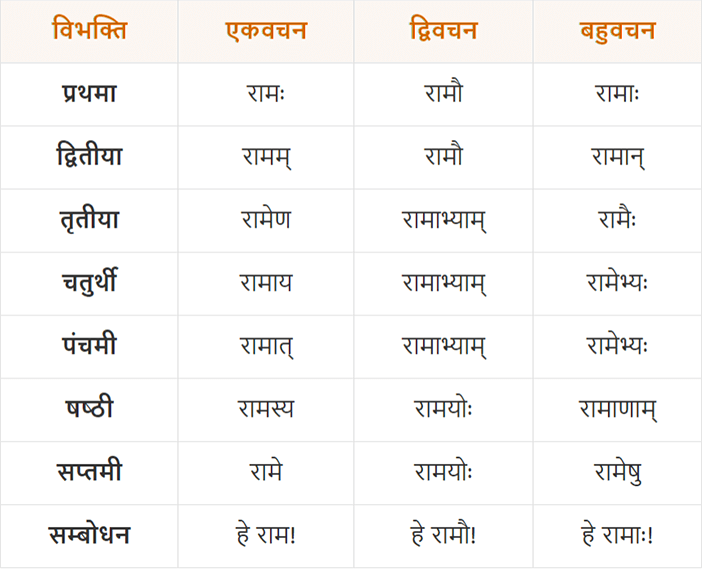The Ram shabd roop is an important aspect of Sanskrit grammar. Understanding the Ram shabd roop in Sanskrit helps in learning how to correctly use the word “Ram” in different cases.
The Ram ka shabd roop and Ram ke shabd roop are essential for students studying Sanskrit. Knowing the shabd roop of Ram in both pulling (masculine) and striling (feminine) forms is crucial. When learning the Ram ka shabd roop in Hindi, it’s helpful to see how it translates as Ram ka shabd roop in Sanskrit. This knowledge also extends to similar words like Ram lata shabd roop.
Ram Shabd Roop in Sanskrit
राम शब्द रूप (Ram Shabd Roop)
| विभक्ति (Vibhakti) | एकवचन (Singular) | द्विवचन (Dual) | बहुवचन (Plural) |
|---|---|---|---|
| प्रथमा (Nominative) | रामः (Rāmaḥ) | रामौ (Rāmau) | रामाः (Rāmāḥ) |
| द्वितीया (Accusative) | रामम् (Rāmam) | रामौ (Rāmau) | रामान् (Rāmān) |
| तृतीया (Instrumental) | रामेण (Rāmeṇa) | रामाभ्याम् (Rāmābhyām) | रामैः (Rāmaiḥ) |
| चतुर्थी (Dative) | रामाय (Rāmāya) | रामाभ्याम् (Rāmābhyām) | रामेभ्यः (Rāmebhyaḥ) |
| पञ्चमी (Ablative) | रामात् (Rāmāt) | रामाभ्याम् (Rāmābhyām) | रामेभ्यः (Rāmebhyaḥ) |
| षष्ठी (Genitive) | रामस्य (Rāmasya) | रामयोः (Rāmayoḥ) | रामाणाम् (Rāmāṇām) |
| सप्तमी (Locative) | रामे (Rāme) | रामयोः (Rāmayoḥ) | रामेषु (Rāmeṣu) |
| संबोधन (Vocative) | हे राम (He Rāma) | हे रामौ (He Rāmau) | हे रामाः (He Rāmāḥ) |
In Sanskrit grammar, the study of “Shabd Roop” (forms of words) is essential for understanding how words change based on their role in a sentence. This article will focus on “Ram Shabd Roop,” which refers to the different forms of the word “राम” (Rama) when used in various grammatical cases. This study is not only fundamental to mastering Sanskrit but also essential for anyone interested in ancient Indian texts, literature, and Hindu philosophy, as “Rama” is a central figure in Indian culture.
Importance of Learning राम शब्द रूप
Understanding the forms of “राम” is crucial because:
- It enhances comprehension of Sanskrit literature, especially epic texts like the Ramayana.
- It aids in the correct interpretation of verses and mantras where the word “Rama” is used in different contexts.
- It deepens the understanding of Sanskrit grammar, which is the foundation of many Indian languages.
Sanskrit Grammar Overview
Before diving into the forms of “राम,” it is helpful to have a basic understanding of Sanskrit grammar. Sanskrit, an ancient Indo-European language, has a highly inflected structure. This means that the endings of words change to express different grammatical categories such as case, number, and gender.
- Case (Vibhakti): There are eight grammatical cases in Sanskrit, each representing a specific function in a sentence.
- Number: Sanskrit nouns and pronouns have three numbers – singular (एकवचन), dual (द्विवचन), and plural (बहुवचन).
- Gender: There are three genders – masculine (पुल्लिंग), feminine (स्त्रीलिंग), and neuter (नपुंसकलिंग).
Declensions of राम (Ram Shabd Roop)
The word “राम” is a masculine noun, and its declension follows a pattern specific to masculine nouns ending in “अ” (a). Below are the forms of “राम” in various cases:
1. प्रथमा विभक्ति (Nominative Case)
The nominative case is used to indicate the subject of a sentence.
- Singular (एकवचन): रामः (Ramah)
- Dual (द्विवचन): रामौ (Ramau)
- Plural (बहुवचन): रामाः (Ramāh)
Examples:
- Singular: रामः वनं गच्छति। (Ramah vanam gacchati.) – Rama goes to the forest.
- Dual: रामौ वनं गच्छतः। (Ramau vanam gacchatah.) – The two Ramas go to the forest.
- Plural: रामाः वनं गच्छन्ति। (Ramāh vanam gacchanti.) – The Ramas go to the forest.
2. द्वितीया विभक्ति (Accusative Case)
The accusative case is used to indicate the object of a verb.
- Singular (एकवचन): रामम् (Ramam)
- Dual (द्विवचन): रामौ (Ramau)
- Plural (बहुवचन): रामान् (Ramān)
Examples:
- Singular: अहम् रामम् पश्यामि। (Aham Ramam pashyāmi.) – I see Rama.
- Dual: अहम् रामौ पश्यामि। (Aham Ramau pashyāmi.) – I see the two Ramas.
- Plural: अहम् रामान् पश्यामि। (Aham Ramān pashyāmi.) – I see the Ramas.
3. तृतीया विभक्ति (Instrumental Case)
The instrumental case is used to indicate the means by which an action is performed.
- Singular (एकवचन): रामेण (Ramena)
- Dual (द्विवचन): रामाभ्याम् (Ramābhyām)
- Plural (बहुवचन): रामैः (Ramaih)
Examples:
- Singular: रामेण वनं गच्छामि। (Ramena vanam gacchāmi.) – I go to the forest with Rama.
- Dual: रामाभ्याम् वनं गच्छामि। (Ramābhyām vanam gacchāmi.) – I go to the forest with the two Ramas.
- Plural: रामैः वनं गच्छामि। (Ramaih vanam gacchāmi.) – I go to the forest with the Ramas.
4. चतुर्थी विभक्ति (Dative Case)
The dative case is used to indicate the recipient of an action.
- Singular (एकवचन): रामाय (Rāmāya)
- Dual (द्विवचन): रामाभ्याम् (Ramābhyām)
- Plural (बहुवचन): रामेभ्यः (Ramebhyah)
Examples:
- Singular: अहम् रामाय पुस्तकं ददामि। (Aham Rāmāya pustakam dadāmi.) – I give the book to Rama.
- Dual: अहम् रामाभ्याम् पुस्तकं ददामि। (Aham Ramābhyām pustakam dadāmi.) – I give the book to the two Ramas.
- Plural: अहम् रामेभ्यः पुस्तकं ददामि। (Aham Ramebhyah pustakam dadāmi.) – I give the book to the Ramas.
5. पञ्चमी विभक्ति (Ablative Case)
The ablative case is used to indicate the point of origin or separation.
- Singular (एकवचन): रामात् (Ramāt)
- Dual (द्विवचन): रामाभ्याम् (Ramābhyām)
- Plural (बहुवचन): रामेभ्यः (Ramebhyah)
Examples:
- Singular: रामात् वनं गच्छामि। (Ramāt vanam gacchāmi.) – I go to the forest from Rama.
- Dual: रामाभ्याम् वनं गच्छामि। (Ramābhyām vanam gacchāmi.) – I go to the forest from the two Ramas.
- Plural: रामेभ्यः वनं गच्छामि। (Ramebhyah vanam gacchāmi.) – I go to the forest from the Ramas.
6. षष्ठी विभक्ति (Genitive Case)
The genitive case is used to indicate possession.
- Singular (एकवचन): रामस्य (Rāmasya)
- Dual (द्विवचन): रामयोः (Rāmayoh)
- Plural (बहुवचन): रामाणाम् (Ramānām)
Examples:
- Singular: एषः रामस्य पुस्तकः अस्ति। (Eshah Rāmasya pustakah asti.) – This is Rama’s book.
- Dual: एषः रामयोः पुस्तकः अस्ति। (Eshah Rāmayoh pustakah asti.) – This is the book of the two Ramas.
- Plural: एषः रामाणाम् पुस्तकः अस्ति। (Eshah Ramānām pustakah asti.) – This is the book of the Ramas.
7. सप्तमी विभक्ति (Locative Case)
The locative case is used to indicate the location or position.
- Singular (एकवचन): रामे (Rame)
- Dual (द्विवचन): रामयोः (Rāmayoh)
- Plural (बहुवचन): रामेषु (Rameshu)
Examples:
- Singular: रामे वनं अस्ति। (Rame vanam asti.) – In Rama, there is a forest.
- Dual: रामयोः वनं अस्ति। (Rāmayoh vanam asti.) – In the two Ramas, there is a forest.
- Plural: रामेषु वनं अस्ति। (Rameshu vanam asti.) – In the Ramas, there is a forest.
8. संबोधन विभक्ति (Vocative Case)
The vocative case is used for addressing someone directly.
- Singular (एकवचन): हे राम (He Rama)
- Dual (द्विवचन): हे रामौ (He Ramau)
- Plural (बहुवचन): हे रामाः (He Ramāh)
Examples:
- Singular: हे राम, कुत्र गच्छसि? (He Rama, kutra gacchasi?) – O Rama, where are you going?
- Dual: हे रामौ, कुत्र गच्छथः? (He Ramau, kutra gacchathah?) – O Ramas, where are you going?
- Plural: हे रामाः, कुत्र गच्छन्ति? (He Ramāh, kutra gacchanti?) – O Ramas, where are you going?
Practical Applications of राम शब्द रूप
Understanding the various forms of “राम” has practical applications in reading, interpreting, and composing Sanskrit texts. Some of the key areas where this knowledge is applied include:
- Religious Texts:
- The Ramayana, one of the most revered epics, uses the word “राम” in various forms. Knowledge of these forms helps in understanding the verses and their meanings.
- Classical Literature:
- In Kalidasa’s works and other classical Sanskrit literature, the word “राम” appears frequently. Correctly interpreting its forms ensures a proper understanding of the text.
- Mantras and Stotras:
- Many Hindu mantras and stotras (hymns) are dedicated to Lord Rama. Knowing the correct forms of “राम” is essential for accurate chanting and understanding.
- Sanskrit Composition:
- For those learning to compose in Sanskrit, understanding how to correctly use “राम” in different cases is crucial for grammatical accuracy.
- Spiritual Study:
- In spiritual studies, especially in the context of Bhakti (devotion) literature, “राम” is a central figure. Understanding its grammatical forms enhances the depth of study.
Tips for Learning राम शब्द रूप
- Practice Regularly: Regular practice of reciting and writing the forms helps in memorizing them.
- Use Mnemonics: Mnemonics can be useful for remembering the cases and their respective forms.
- Apply in Sentences: Try to use the forms of “राम” in simple sentences to understand their usage better.
- Study with a Group: Learning with others can make the process engaging and can help in better retention.
Understanding the “राम शब्द रूप” is a fundamental aspect of Sanskrit grammar, providing insights into how words function within sentences. Whether you are a student of Sanskrit, a spiritual seeker, or simply someone interested in the rich cultural heritage of India, mastering these forms will enhance your appreciation and understanding of the language and its literature. By regularly practicing and applying this knowledge, you can deepen your comprehension of Sanskrit texts and enjoy the beauty of one of the world’s oldest languages.
FAQ for Ram Shabd Roop
Q1: What is the meaning of “Shabd Roop”?
- A1: “Shabd Roop” refers to the different grammatical forms a noun or pronoun takes depending on its case (vibhakti), number (singular, dual, plural), and gender in Sanskrit. It’s essential for understanding how words change in a sentence.
Q2: How many cases (vibhakti) are there in Sanskrit?
- A2: There are eight grammatical cases (vibhakti) in Sanskrit: Nominative (प्रथमा), Accusative (द्वितीया), Instrumental (तृतीया), Dative (चतुर्थी), Ablative (पञ्चमी), Genitive (षष्ठी), Locative (सप्तमी), and Vocative (संबोधन).
Q3: What is the significance of learning राम शब्द रूप?
- A3: Learning राम शब्द रूप is crucial for understanding and interpreting Sanskrit literature, religious texts like the Ramayana, and mantras dedicated to Lord Rama. It also aids in correct sentence formation and grammar comprehension.
Q4: How is “राम” declined in the nominative case?
- A4: In the nominative case, “राम” is declined as follows:
- Singular: रामः (Ramah)
- Dual: रामौ (Ramau)
- Plural: रामाः (Ramāh)
Q5: Can you provide an example of “राम” in the accusative case?
- A5: Yes, here’s an example:
- Singular: रामम् (Ramam) – अहम् रामम् पश्यामि। (Aham Ramam pashyāmi.) – I see Rama.
- Dual: रामौ (Ramau) – अहम् रामौ पश्यामि। (Aham Ramau pashyāmi.) – I see the two Ramas.
- Plural: रामान् (Ramān) – अहम् रामान् पश्यामि। (Aham Ramān pashyāmi.) – I see the Ramas.
Q6: Why are there different forms for “राम” in dual and plural numbers?
- A6: Sanskrit has a rich grammatical structure that differentiates between singular, dual, and plural numbers. The dual form is used for two objects, while the plural is for more than two. This allows for precise expression of quantity.
Q7: How is “राम” used in the genitive case?
- A7: In the genitive case, “राम” expresses possession:
- Singular: रामस्य (Rāmasya) – This is Rama’s book.
- Dual: रामयोः (Rāmayoh) – This is the book of the two Ramas.
- Plural: रामाणाम् (Ramānām) – This is the book of the Ramas.
Q8: What are some practical applications of learning राम शब्द रूप?
- A8: Practical applications include:
- Understanding and interpreting ancient texts like the Ramayana.
- Correctly chanting and understanding mantras dedicated to Lord Rama.
- Writing and composing in Sanskrit with grammatical accuracy.
Q9: How can I effectively learn and remember the forms of “राम”?
- A9: To effectively learn and remember the forms:
- Practice regularly by writing and reciting the forms.
- Use mnemonics to associate forms with meanings.
- Apply the forms in simple sentences to understand their usage.
- Study in groups or with a tutor for better retention.
Q10: Are there any resources available for practicing राम शब्द रूप?
- A10: Yes, there are several resources available, including:
- Sanskrit grammar books that cover declensions and their usage.
- Online tutorials and courses that teach Sanskrit grammar.
- Practice sheets and exercises specifically designed for learning शabd Roop.
Q11: Is understanding राम शब्द रूप essential for learning other Sanskrit words?
- A11: Yes, understanding the declension pattern of “राम” provides a foundation for learning the forms of other similar masculine nouns in Sanskrit, making it easier to grasp the grammar of the language as a whole.
Q12: What are the forms of “राम” in the locative case?
- A12: In the locative case, “राम” is used to indicate location:
- Singular: रामे (Rame)
- Dual: रामयोः (Rāmayoh)
- Plural: रामेषु (Rameshu)
Q13: Can you explain the instrumental case with an example?
- A13: In the instrumental case, “राम” indicates the means or instrument of an action:
- Singular: रामेण (Ramena) – I go to the forest with Rama.
- Dual: रामाभ्याम् (Ramābhyām) – I go to the forest with the two Ramas.
- Plural: रामैः (Ramaih) – I go to the forest with the Ramas.
Q14: How does the understanding of राम शब्द रूप help in spiritual studies?
- A14: Understanding the grammatical forms of “राम” enhances the comprehension of spiritual texts and hymns, deepening the study and meditation on the attributes and stories of Lord Rama, a central figure in Hindu spirituality.







